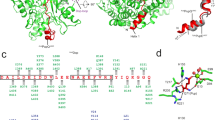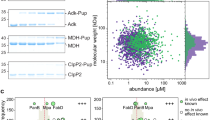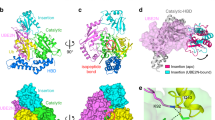Abstract
In analogy to ubiquitin in eukaryotes, the bacterial protein Pup is attached to lysine residues of substrate proteins, thereby targeting them for proteasomal degradation. It has been proposed that, before its attachment, Pup is modified by deamidation of its C-terminal glutamine to glutamate. Here we have identified Dop (locus tag Rv2112) as the specific deamidase of Pup in Mycobacterium tuberculosis. Deamidation requires ATP as a cofactor but not its hydrolysis. Furthermore, we provide experimental evidence that PafA (locus tag Rv2097) ligates deamidated Pup to the proteasomal substrate proteins FabD and PanB. This formation of an isopeptide bond requires hydrolysis of ATP to ADP, suggesting that deamidated Pup is activated for conjugation via phosphorylation of its C-terminal glutamate. By combining these enzymes, we have reconstituted the complete bacterial ubiquitin-like modification pathway in vitro, consisting of deamidation and ligation steps catalyzed by Pup deamidase (Dop) and Pup ligase (PafA).
This is a preview of subscription content, access via your institution
Access options
Subscribe to this journal
Receive 12 print issues and online access
$189.00 per year
only $15.75 per issue
Buy this article
- Purchase on Springer Link
- Instant access to full article PDF
Prices may be subject to local taxes which are calculated during checkout





Similar content being viewed by others
References
Baumeister, W., Walz, J., Zühl, F. & Seemüller, E. The proteasome: paradigm of a self-compartmentalizing protease. Cell 92, 367–380 (1998).
Goldberg, A.L. Functions of the proteasome: from protein degradation and immune surveillance to cancer therapy. Biochem. Soc. Trans. 35, 12–17 (2007).
Pickart, C.M. & Cohen, R.E. Proteasomes and their kin: proteases in the machine age. Nat. Rev. Mol. Cell Biol. 5, 177–187 (2004).
Inobe, T. & Matouschek, A. Protein targeting to ATP-dependent proteases. Curr. Opin. Struct. Biol. 18, 43–51 (2008).
Kerscher, O., Felberbaum, R. & Hochstrasser, M. Modification of proteins by ubiquitin and ubiquitin-like proteins. Annu. Rev. Cell Dev. Biol. 22, 159–180 (2006).
Elsasser, S. & Finley, D. Delivery of ubiquitinated substrates to protein-unfolding machines. Nat. Cell Biol. 7, 742–749 (2005).
Husnjak, K. et al. Proteasome subunit Rpn13 is a novel ubiquitin receptor. Nature 453, 481–488 (2008).
Burns, K.E., Liu, W.T., Boshoff, H.I., Dorrestein, P.C. & Barry, C.E., III. Proteasomal protein degradation in mycobacteria is dependent upon a prokaryotic ubiquitin-like protein. J. Biol. Chem. 284, 3069–3075 (2009).
Pearce, M.J., Mintseris, J., Ferreyra, J., Gygi, S.P. & Darwin, K.H. Ubiquitin-like protein involved in the proteasome pathway of Mycobacterium tuberculosis . Science 322, 1104–1107 (2008).
Lin, G. et al. Mycobacterium tuberculosis prcBA genes encode a gated proteasome with broad oligopeptide specificity. Mol. Microbiol. 59, 1405–1416 (2006).
Tamura, T. et al. The first characterization of a eubacterial proteasome: the 20S complex of Rhodococcus . Curr. Biol. 5, 766–774 (1995).
Darwin, K.H., Lin, G., Chen, Z., Li, H. & Nathan, C.F. Characterization of a Mycobacterium tuberculosis proteasomal ATPase homologue. Mol. Microbiol. 55, 561–571 (2005).
Pearce, M.J. et al. Identification of substrates of the Mycobacterium tuberculosis proteasome. EMBO J. 25, 5423–5432 (2006).
Darwin, K.H., Ehrt, S., Gutierrez-Ramos, J.C., Weich, N. & Nathan, C.F. The proteasome of Mycobacterium tuberculosis is required for resistance to nitric oxide. Science 302, 1963–1966 (2003).
Zhang, X. et al. The N-terminal coiled coil of the Rhodococcus erythropolis ARC AAA ATPase is neither necessary for oligomerization nor nucleotide hydrolysis. J. Struct. Biol. 146, 155–165 (2004).
Festa, R.A., Pearce, M.J. & Darwin, K.H. Characterization of the proteasome accessory factor (paf) operon in Mycobacterium tuberculosis . J. Bacteriol. 189, 3044–3050 (2007).
Iyer, L.M., Burroughs, A.M. & Aravind, L. Unraveling the biochemistry and provenance of pupylation: a prokaryotic analog of ubiquitination. Biol. Direct 3, 45 (2008).
Li, Z. et al. The crystal structure of MCAT from Mycobacterium tuberculosis reveals three new catalytic models. J. Mol. Biol. 371, 1075–1083 (2007).
Abbott, J.J. et al. Structure prediction and active site analysis of the metal binding determinants in γ-glutamylcysteine synthetase. J. Biol. Chem. 276, 42099–42107 (2001).
Jez, J.M., Cahoon, R.E. & Chen, S. Arabidopsis thaliana glutamate-cysteine ligase: functional properties, kinetic mechanism, and regulation of activity. J. Biol. Chem. 279, 33463–33470 (2004).
Unno, H. et al. Atomic structure of plant glutamine synthetase: a key enzyme for plant productivity. J. Biol. Chem. 281, 29287–29296 (2006).
Hibi, T. et al. Crystal structure of γ-glutamylcysteine synthetase: insights into the mechanism of catalysis by a key enzyme for glutathione homeostasis. Proc. Natl. Acad. Sci. USA 101, 15052–15057 (2004).
Ronzio, R.A. & Meister, A. Phosphorylation of methionine sulfoximine by glutamine synthetase. Proc. Natl. Acad. Sci. USA 59, 164–170 (1968).
Ronzio, R.A., Rowe, W.B. & Meister, A. Studies on the mechanism of inhibition of glutamine synthetase by methionine sulfoximine. Biochemistry 8, 1066–1075 (1969).
Abbott, J.J., Ford, J.L. & Phillips, M.A. Substrate binding determinants of Trypanosoma brucei γ-glutamylcysteine synthetase. Biochemistry 41, 2741–2750 (2002).
Huang, C.S., Moore, W.R. & Meister, A. On the active site thiol of γ-glutamylcysteine synthetase: relationships to catalysis, inhibition, and regulation. Proc. Natl. Acad. Sci. USA 85, 2464–2468 (1988).
Tu, Z. & Anders, M.W. Identification of an important cysteine residue in human glutamate-cysteine ligase catalytic subunit by site-directed mutagenesis. Biochem. J. 336, 675–680 (1998).
Thompson, J.D., Higgins, D.G. & Gibson, T.J. CLUSTAL W: improving the sensitivity of progressive multiple sequence alignment through sequence weighting, position-specific gap penalties and weight matrix choice. Nucleic Acids Res. 22, 4673–4680 (1994).
Daugelat, S. et al. The RD1 proteins of Mycobacterium tuberculosis: expression in Mycobacterium smegmatis and biochemical characterization. Microbes Infect. 5, 1082–1095 (2003).
Levitzki, A. Determination of submicro quantities of ammonia. Anal. Biochem. 33, 335–340 (1970).
Acknowledgements
We thank the staff at the Functional Genomics Center Zurich (FGCZ) for MS, A. Geerlof (European Molecular Biology Laboratory, Hamburg) for the pMyC expression vector, the Richmond laboratory (ETH Zürich) for the His6-Thioredoxin-TEV fusion vector and P. Sander (University of Zurich) for the mycobacterial strains. This work was supported by the Swiss National Science Foundation (SNF), the National Center for Excellence in Research (NCCR) Structural Biology program of the SNF, an ETH research grant and a Kekulé fellowship by the 'Fonds der Chemischen Industrie' to F.S.
Author information
Authors and Affiliations
Corresponding author
Supplementary information
Supplementary Text and Figures
Supplementary Figures 1–6 and Supplementary Table 1 (PDF 1972 kb)
Rights and permissions
About this article
Cite this article
Striebel, F., Imkamp, F., Sutter, M. et al. Bacterial ubiquitin-like modifier Pup is deamidated and conjugated to substrates by distinct but homologous enzymes. Nat Struct Mol Biol 16, 647–651 (2009). https://doi.org/10.1038/nsmb.1597
Received:
Accepted:
Published:
Issue Date:
DOI: https://doi.org/10.1038/nsmb.1597
This article is cited by
-
Structures of prokaryotic ubiquitin-like protein Pup in complex with depupylase Dop reveal the mechanism of catalytic phosphate formation
Nature Communications (2021)
-
Deciphering Molecular Virulence Mechanism of Mycobacterium tuberculosis Dop isopeptidase Based on Its Sequence–Structure–Function Linkage
The Protein Journal (2020)
-
Protein post-translational modifications in bacteria
Nature Reviews Microbiology (2019)
-
Prokaryotic ubiquitin-like protein remains intrinsically disordered when covalently attached to proteasomal target proteins
BMC Structural Biology (2018)
-
A proximity-tagging system to identify membrane protein–protein interactions
Nature Methods (2018)



